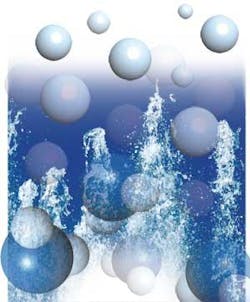UV light makes hydrogen from water

A demonstration that near-ultraviolet lasers can initiate production of hydrogen from water under high pressure is promising for hydrogen fuel production in the future. By themselves, carbon monoxide and nitrogen are virtually inert–but adding water and then irradiation with a continuous wave (CW) low-power 350-nm argon laser under a pressure of 1000 atmospheres enabled the production of gaseous hydrogen and other molecules.
Researchers with the European Laboratory for Non-Linear Spectroscopy at Italy’s University of Florence conducted the investigation, and used spectroscopy to identify the molecules generated by the process. “The lasers break down water into hydrogen and hydroxyl radicals, and these free radicals catalyze further reactions in the partner materials,” say Roberto Bini and his colleagues.
The authors suggest that large-volume pressurized irradiation reactors could be used for sustainable chemistry processes, including the generation of hydrogen for use as fuel.
According to Princeton University (Princeton, NJ), the most common method of hydrogen production involves the formation of syngas from fossil fuels.
Bias obscures effectiveness of laser therapy for back pain
“The financial justification for the use of laser therapy as the first line of defense in disc herniations is overwhelming,” wrote Fred Kahn, MD, FRCS(c) and Michael Patterson, MSc in the July 15, 2009 edition of Dynamic Chiropractic. Their article, titled “Laser Therapy for Disc Herniations,” cited data collected in one trial that calculated the average cost for surgery to relieve lower back pain at $15,139—and $27,341 when other costs such as diagnostic tests and missed work are factored in (the cost of conservative treatment in the same study averaged $13,108). “In our experience, even the most extreme example of a herniated disc patient (receiving 40 treatments), resulted in a total treatment cost of just $3,200,” they said. “When diagnostic tests and health care visits are factored into this equation, the total cost of laser therapy is closer to $5,700.”
Besides the significant cost savings, laser therapy is noninvasive–and no adverse events have been reported in more than 3,000 publications, the authors say. And yet, there seems to be a bias in the literature against laser therapy—or perhaps more accurately, a predilection for the status quo.
The authors explain that there is substantial published research on the effectiveness of laser therapy in treating lower back pain (LBP) and lumbar disc herniations. But these studies seem to be absent in reviews from either the American Pain Society/American College of Physicians or the Cochrane Collaboration. For instance, a review of laser therapy for low back pain performed by the American Pain Society/American College of Physicians included four trials (566 patients) that demonstrated laser therapy was effective and one trial (140 patients) found laser therapy to be no more beneficial than a sham laser device. Still, the conclusion from this review was, “Non-invasive therapies (low-level laser therapy) have not been shown to be effective for chronic, sub-acute or acute low back pain.”
Kahn and Patterson say that a letter to the authors of the review regarding their bias against laser therapy and in support of pharmaceuticals only prompted the latter to downgrade the evidence supporting acetaminophen.
“In our experience, almost 40 percent of all patients presenting for treatment suffer from back problems characterized by severe pain, and more than 85 percent can be treated successfully with laser therapy,” say Kahn and Patterson. “We conclude that medical convention has demonstrated that the relief of symptomatic disc herniations continues to be problematic; and that both conservative and surgical solutions in the majority of cases appear to be equally ineffective.”
Dr. Kahn founded Meditech International Inc. in 1989 and developed the Low Intensity Laser Therapy system known as BioFlex. Patterson is Meditech’s research and education manager.

Barbara Gefvert | Editor-in-Chief, BioOptics World (2008-2020)
Barbara G. Gefvert has been a science and technology editor and writer since 1987, and served as editor in chief on multiple publications, including Sensors magazine for nearly a decade.